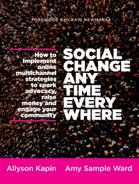Chapter Six
Multichannel Strategies in Action
Now that we’ve covered the “why” behind using multichannel strategies for advocacy, fundraising, and community engagement, let’s dive into some of the ins and outs of real campaigns. This chapter is designed to give you the behind-the-scenes tour of real campaigns from a few organizations to show what multichannel strategies look like in action. These three case studies, from National Wildlife Federation, Surfrider Foundation, and Iraq and Afghanistan Veterans of America, show how organizations bring everything together to incorporate advocacy, fundraising, and community building across channels.
OIL SPILL CRISIS: NATIONAL WILDLIFE FOUNDATION’S MULTICHANNEL CAMPAIGN RESPONSE
When an explosion on the Deepwater Horizon oil drilling rig ignited a fire that could not be extinguished on April 20, 2010, resulting in the oil rig sinking two days later, the oil well continued gushing at the seabed.92 The spill was the largest offshore oil spill in U.S. history, and the National Wildlife Federation (NWF) jumped to action with a multichannel disaster response campaign.
Goals
NWF’s campaign had two overarching campaign goals:
Within those two areas of focus for the campaign, NWF identified a number of short-term goals that would influence messaging, provide context for calls to action, and ultimately give structure to their strategy.
Get Information About the Spill to as Many People as Possible
With NWF staff and volunteers near the oil spill area, NWF was one of the primary resources for distributing information to the public about the spill and its impact on wildlife. “People wanted to know what was happening and how many wildlife were being hurt,” said Kristin Johnson, senior manager for online integration at NWF. Within the first 24 hours of the spill, NWF created a microsite to aggregate the news, blogs, and other information about where the organization needed people’s help.93 They also created a Flickr group featuring oil spill photos and invited a number of people taking photos of the oil slick to join and share their images. This was an important tactic, especially with BP shutting the public out of most coastal areas due to safety reasons. Since local NWF staff immediately started seeing inconsistencies in the numbers BP reported, it was crucial to have an easy and fast way to spread on-the-ground information to the public. This was especially important in order to hold BP accountable for the full extent of the disaster.
Get Resources to Where They Are Needed
NWF’s work focused on determining what was needed on the ground to help wildlife and connecting those needs with resources. They recruited volunteers to help monitor wildlife rescue efforts. They asked for gloves and other supplies for volunteers who were working in the Gulf area. They urged people to attend important events and to send messages to their members of Congress when relevant legislation needed to be passed.
Fix the Damage
In the first few months of the oil disaster, most of NWF’s focus was on the direct response needed to help wildlife. For example, when hundreds of sea turtle nests needed to be moved to a safer beach, NWF helped fund the effort and recruited volunteers. When the hotline for reporting injured wildlife wasn’t working, they enlisted their supporters to let BP know about the problems and got it fixed by BP in a timely manner.
Help People Cope
In times of tragedy social media channels can be used as an emotional support system for people who are looking for comfort. NWF saw many people in their community who were feeling helpless and sad about the tragedy. “We provided comfort where appropriate, or just allowed people a place to just express how bad they were feeling,” said Johnson.
Long-Term Goal
NWF realized that in the long term, the oil spill was going to be impacting the Gulf for decades to come. Over time, they would need to transition their volunteer efforts from surveillance to restoration, and continue to fight for legislative funding to ensure that the Gulf received the financial help it needed. Two years later, NWF’s legislative priority was for Congress to pass the RESTORE Act. This is legislation that ensures that at least 80% of the billions of dollars in potential fines that BP pays goes to fixing the damage they caused. Without the RESTORE Act, the fines would go into a general fund and be used for other projects. In June of 2012, Congress passed the bill.
Channels
The oil spill was a huge story in the media, and people were seeing very disturbing photos of oil-covered pelicans, dolphins, and other wildlife. So many people wanted to channel their grief by doing something to help, but it wasn’t obvious how. “We immediately found it useful to not only be sharing information about the impact the spill had on wildlife, but also to share ways people could help, even if it was as simple as making sure this catastrophe didn’t get swept under the rug and forgotten about,” said Johnson. NWF even filed a Freedom of Information Act request to make sure the oiled wildlife totals were made public.
Online and Offline
NWF helped to organize volunteers on the ground and on the water to monitor beaches and the Gulf to report wildlife in distress.
Website
Among all the people grieving about the oil spill and sharing with NWF online, many were children. To help parents know what to share with their children and how to share it, the editors of NWF’s children’s magazine, Ranger Rick,94 pulled together child-friendly web content for their website and also helped advise NWF social media staff as to how they should interact with children who were reaching out to them online.
NWF set up campaign action pages on their website where people could contact their members of Congress to advocate for restoration and for holding BP accountable to fix the damage they caused.
Facebook and Twitter
To reach their community and new people interested in protecting wildlife, NWF adapted their campaign messaging across several channels. “We actually sketched out an initial plan of attack and sample messages for each channel. And when we rolled it out, we instantly picked up on what was working and how people were responding or not responding,” said Johnson.
NWF posted a couple of links each day. “We had to be careful that they weren’t all sad and depressing, or we saw people become immobilized in grief and feeling hopeless. We also saw many people posting to our wall about the fundraisers they were holding for NWF, so we maintained a very thankful, humble, grateful tone—which was completely sincere. We were blown away by people every day,” said Johnson.
To spread the information as quickly as possible and keep the momentum going, NWF collaborated with their community to reshare important updates, resources, and data. “Whether or not someone could donate or volunteer in person, we made it clear that it was also important for them to donate their time to share links, articles, and information about what was happening,” said Johnson.
NWF also viewed their social channels, blog, and website as a vehicle to connect with reporters and help disperse credible information. NWF’s social media and communications staff tuned in to the stories of the day, retweeted articles, shared them on Facebook, and tagged reporters/bloggers in the message. “We even saw articles we were sharing on Twitter being reported as news on CNN, attributed to NWF tweets,” said Johnson.
Flickr
NWF recognized from the start of the campaign how much their outreach was going to be very dependent on images, so they chose Flickr as the primary platform to post photos that documented the oil spill’s impact on wildlife. This enabled their staff in Louisiana and along the coast to upload images quickly, as well as to create a Flickr group for other photographers, as we mentioned earlier. NWF searched daily for new images and photographers to recruit to the group, and also asked photographers for the rights to use their images on the NWF website.
NWF sent a variety of email and direct mail appeals to their members and activists that updated them about what NWF was doing on the ground and how supporters could help, such as by donating money, volunteering, and contacting their members of Congress to advocate for restoration.
Immediately after the oil spill, NWF started a restricted fund specific to the oil disaster, and cultivated donations online, by mail, by phone, text-to-give, and from multiple social fundraising platforms. Figure 6.1 shows a screen shot of the oil spill donation page.
Figure 6.1 Example of NWF Fundraising Appeal
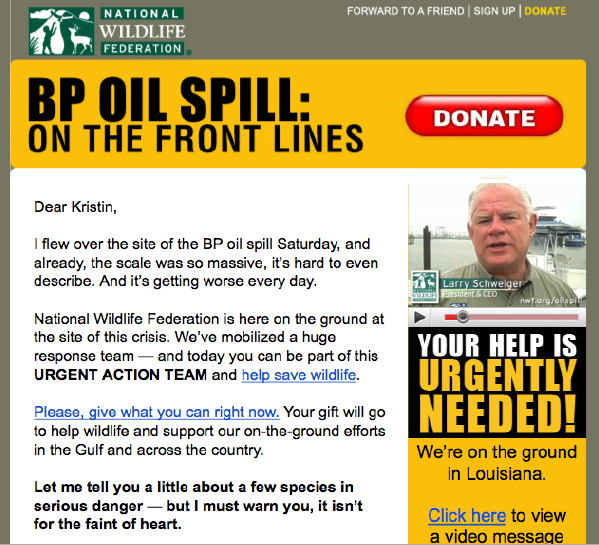
Causes
As we have discussed earlier in the book, when you build a strong community across multiple channels, your community will support you in times of need. In the case of the oil spill, NWF’s community immediately started fundraising for NWF without NWF even asking. NWF’s biggest social fundraiser was a page they set up on Causes.org. It was featured on the Causes homepage and immediately embraced by the Causes community, where more than a million people joined and donated.
Supporters sold crafts and created their own birthday fundraisers on Causes. Children organized lemonade stands and bake sales, where proceeds were donated to NWF. “While this wasn’t necessarily something that we planned into our outreach from the start, we did our best to thank everyone and make sure they had what they needed for their events. We also shared what people were doing and that inspired even more fundraisers,” said Johnson.
Text-to-Give
Within the first 24 hours, NWF quickly set up their first ever, major text-to-give campaign where people could text “Wildlife” to a shortcode to donate $10. Since NWF was one of the leading experts in wildlife, and were quickly aggregating reports and resources, major news networks and blogs were interviewing and featuring their staff in news stories. This media exposure gave the organization even more leverage to promote the text-to-give campaign to a much wider audience. They also utilized the following channels to promote the text-to-give campaign:
- For the NWF website, they posted banner ads and graphics, which helped get the word out to their website visitors.
- For Twitter, they incorporated the text shortcode in several tweets, which was retweeted by a considerable number of supporters, including by celebrities with very large followings. They also featured and embedded the “Text ‘wildlife’ to 20222” graphic into their Twitter background.
- For Facebook, they mentioned the text-to-give campaign on their Page and included it in their comments when they were responding to people asking for ways to help. “But our approach with Facebook was to make sure our community always felt like they were getting content that was valuable to them,” said Johnson. This aligns with the strategy we discussed in the fundraising chapter (Chapter Four)—don’t always ask your donors for money; give them several ways to engage with your organization.
Ads
NWF was fortunate enough to receive donated ads and travel as one of three charities chosen for the CNN “Disaster in the Gulf Telethon.” “Really, we didn’t use any paid promotion, and really did our best to make sure the money being donated was going to our work in the Gulf and to on the ground projects that smaller charities needed help with,” said Johnson.
Results
Measuring metrics and real-world impact can be challenging when you are in the middle of a rapid response multichannel campaign. Johnson said that while NWF made every effort to set up source codes to track how people were responding to email actions and fundraising appeals, it was difficult to truly track the outpouring of support they saw for the wildlife and communities in the Gulf. NWF said they raised a significant amount of money, including $120,000 from the fundraising effort on Causes. They also had thousands of people sending messages to decision makers, and many people retweeting messages or sharing blogs. However, the numbers that NWF were most concerned with tracking were those indicating the impact they made on the ground to make things better for wildlife, including
- Training and organizing 250 wildlife surveillance volunteers to help monitor more than 2,500 miles of coast in the months following the spill. They even had a scuba group volunteer to take underwater photos off the coast of Florida before the oil got there to capture the current state of the reefs before the oil hit.
- More than 400 volunteers helping with events that included restoring fragile nesting habitats in dunes, building oyster reefs, and replanting marsh grasses.
- Showing reporters from major news outlets the impacts of the spill in remote wetland areas that included key pelican nesting habitats, which generated media coverage for NWF.
- Helping relocate more than 250 sea turtle nests (a nest has about 100 eggs) to safer beaches in an effort with the Sea Turtle Conservancy to give the endangered and threatened turtles a chance to survive.
- Directly impacting the passage of the RESTORE Act in Congress and continuing to make sure that BP will not only pay their fines, but also ensure that those fines go to restoring the damaged habitat.
Lessons
“We had no instruction manual on the shelf called ‘What to do when an oil rig explodes in the Gulf.’ It was written page by page, on the fly in the weeks and months after,” said Johnson. NWF learned that by identifying point people from all departments who would meet daily, they were able to get the information they needed from the field and review and vet reports that NWF staff were seeing on social media channels and blogs. This helped NWF staff be on same page and help each other out, since reports were coming from a variety of sources. Johnson also said that the organization had to organize their internal communications to make sure that any staff that were talking to the media or on social media were properly equipped to talk about the facts around the oil spill and its impact on wildlife.
NWF said that the oil spill was also a lesson in streamlining their website processes and using their website to post the latest news and actions people could take. “We stressed that up front. Wherever you are, whatever you’re putting out, redirect people to the oil spill website for the latest information,” said Johnson.
Johnson said that had they not streamlined their internal web processes and used their website as the main source of updated information on the oil spill and wildlife, the campaign would not have run smoothly. “We would have had different, possibly inaccurate information coming out on our online channels [social media, email, blog, etc.]. We would have also posted a lot more duplicative or conflicting web content as our media team, magazine team, and online team were trying to get information online as fast as possible,” said Johnson.
BAN THE BAG: SURFRIDER FOUNDATION’S MULTICHANNEL ADVOCACY CAMPAIGN
The Surfrider Foundation is a grassroots organization that works to protect the world’s oceans and beaches through local organizing. Volunteers often lead Surfrider Foundation chapters at the local level. When the Portland, Oregon chapter was looking to reduce plastic pollution in the ocean, they launched the Ban the Bag campaign.
Goals
The immediate goal for the Ban the Bag campaign in Portland was to get local residents to write Portland City Council members and urge them to support legislation that banned single-use plastic bags in the city.
Channels
After finalizing their goals, they identified their target audience—local Portlanders who cared about the ocean, sustainability, and plastic pollution. Then they used multiple channels such as email, Facebook, and offline events to reach their target audience. According to Tara Gallagher, the Portland Chapter Outreach Coordinator, almost all of their online outreach and organizing was done through their Facebook Page, where they promoted petitions, events, and news coverage. They also sent out action alerts to their membership and asked people to share it with their friends and colleagues via email and social networks.
Offline organizing and promotion was also integrated into their multichannel campaign. For example, they distributed handbills and flyers to advertise local rallies supporting the Ban the Bag campaign that also linked back to their campaign website. They did presentations to conservation groups and recycling groups. In addition, they gathered petition signatures at a variety of events, including local concerts and festivals. And, most important, they got stakeholder buy-in through meetings with the mayor’s office, grocers, and other parties who had a stake in the campaign.
Results
It took the Surfrider Foundation about four years to get plastic bags banned in Portland, but it was well worth it since the campaign actually became much larger and evolved into a statewide ban of plastic bags. During the campaign, Surfrider Foundation operated on a shoe-string budget and generated
- 10,000 petition signatures
- 4,924 Facebook “likes,” a number that is still growing
- Hundreds of citizens attending the rallies
- Media coverage in The Oregonian, which was then reposted numerous times on Facebook, a cover story on the Willamette Week, and many more
“Not bad for an all volunteer group with an operating budget of $5,000 to $10,000! Social media has definitely allowed groups like ours to make an impact on a greater scale,” said Gallagher.
Lessons
When campaigns grow beyond the initial geographic goal or even action target, it’s important to document what you’re doing and learning in ways that can be immediately shared with your partners or affiliates. In the case of the Ban the Bag campaign in Portland, as the effort grew to a statewide reach, sharing the successful strategies and tactics with campaigners outside of Portland was incredibly valuable.
Another aspect of campaigns that grow like Ban the Bag did is the impact on messaging. When the campaign launched, the focus was on a Portland-area change and the estimated timeline was much shorter. If your campaign changes its focus or duration, it’s important to rescale the messaging to match. This will ensure that you are being transparent and consistent, as well as let you set the tone for the community as more supporters join.
MEMORIAL DAY: IAVA’S #GOSILENT MULTICHANNEL COMMUNITY CAMPAIGN
In the United States, the last Monday in May each year is Memorial Day, a federal holiday in remembrance of the men and women who died while serving in the United States Armed Forces. Iraq and Afghanistan Veterans of America (IAVA), the first and largest nonprofit, nonpartisan organization for Iraq and Afghanistan vets, with over 200,000 members and supporters nationwide, created a multichannel campaign to build community and call supporters to action for Memorial Day 2012.
Goals
Running a community-focused campaign on Memorial Day was an obvious choice for IAVA given that veterans and their families are the core members of its community. “For the veteran community, Memorial Day involves more collective reflection than nearly any other day of the year,” said Megan Hemler, digital engagement director for IAVA. Memorial Day weekends for many are not always focused on veterans, though, which meant this campaign was an opportunity for IAVA to advance its mission and bring focus back to the purpose for the holiday. According to Hemler: “For the general public, it is a holiday associated primarily with BBQs and long weekends. Our “Go Silent” campaign was an attempt to bridge those two worlds, by inviting all Americans to honor the fallen.”
IAVA decided on the name #GoSilent for the campaign—asking people to pledge to “go silent” at 12:01 P.M. Eastern time in honor of all those who gave their life in service, to coincide with President Obama’s remarks at Arlington National Cemetery. Because the action required nothing more than an individual to take a moment to reflect, people could pledge to participate at any time and actually take a moment of silence at any time, even if it was before or after the ceremony in Arlington. This meant that the campaign messages and calls to action could feel timely and specific but the action was something supporters could complete at any time.
The campaign focused on engaging current IAVA members and supporters, giving them an opportunity to feel united and focused. Because of the national focus of the holiday, a campaign on the same topic meant there was opportunity to attract attention from people in the public eye such as politicians and celebrities who wanted to show their support for the cause. For example, Senator Ron Johnson (on Twitter as @SenRonJohnson) tweeted “I’ll be ‘going silent’ at 11:01 CT today, in remembrance of those who gave their lives for America. iava.org #GoSilent.” It was also a great opportunity to grow the community organically as people used the web to learn more about veterans and find IAVA’s information.
As Hemler explained, “This one action, carrying one message, was crucial to our success—while complex campaigns with multiple tiers of engagement can be successful, Memorial Day was not complex to us. And we knew it was not complex to the veteran community. Stand with us in our silence, we asked—take a single moment from the BBQ or the beach to honor the men and women who have sacrificed their lives for that liberty.”
Channels
IAVA staff would be offline at President Obama’s presentation in Arlington at 12:01 for the moment of silence. However, they knew that online channels would be crucial to promote the campaign ahead of time as well as to document the offline ceremony and share it in real-time with supporters all over the country. “When deciding the best channels for this campaign,” Hemler said, “we knew that we should expect higher than normal traffic to our primary website, IAVA.org, due to Google searches around the word “veteran” and increased Facebook activity around the topic. We also wanted to use our large social media following (over 370,000 Facebook Fans) to bring people into the campaign organically, by tailoring the content and possible actions to different, yet relevant, platforms.”
Website
IAVA staff knew where they were connected to their community (Facebook and other social channels), as well as where they would be able to reach new visitors (primarily their website). They made the channel for those new to the organization streamlined and focused on the campaign. “We reached a final decision of a full-screen splash page on IAVA.org as the homepage for #GoSilent, with a simple form to pledge one minute of silence in solidarity with our community, coinciding with the laying of the wreath at the Tomb of the Unknown.” You can see the splash page in Figure 6.2.
Figure 6.2 Screen Shot of the #Go Silent Campaign Microsite
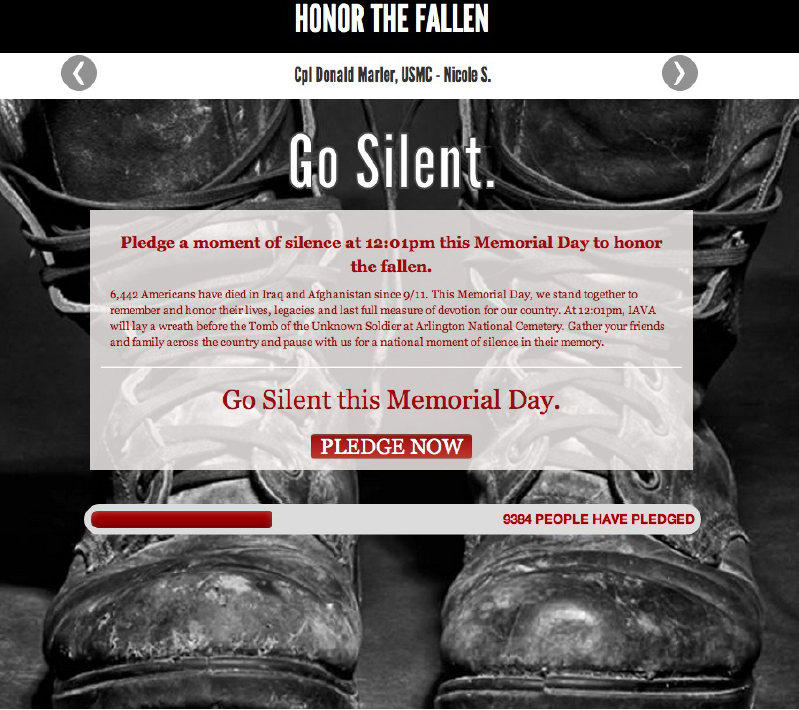
As Hemler explained, “[The] petition page was directly connected to our database for easy data collection and analysis—and initiated an automatic thank you email to those who pledged, encouraging them to spread the word and sign up for text reminders shortly before the moment of silence.” Figure 6.3 is the petition page Hemler mentions. You can see that only the most critical information was requested keeping the form quick to complete.
Figure 6.3 #Go Silent Campaign Sign-up Form
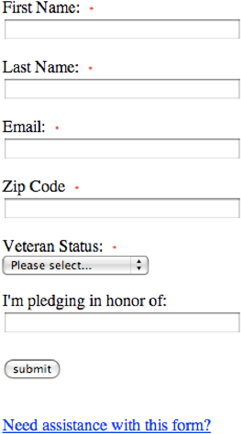
Figure 6.4 shows the confirmation page after completing the pledge to “go silent.” The social sharing buttons are prominent and the number of people who have pledged increases.
Figure 6.4 #Go Silent Campaign Sign-up Confirmation Page
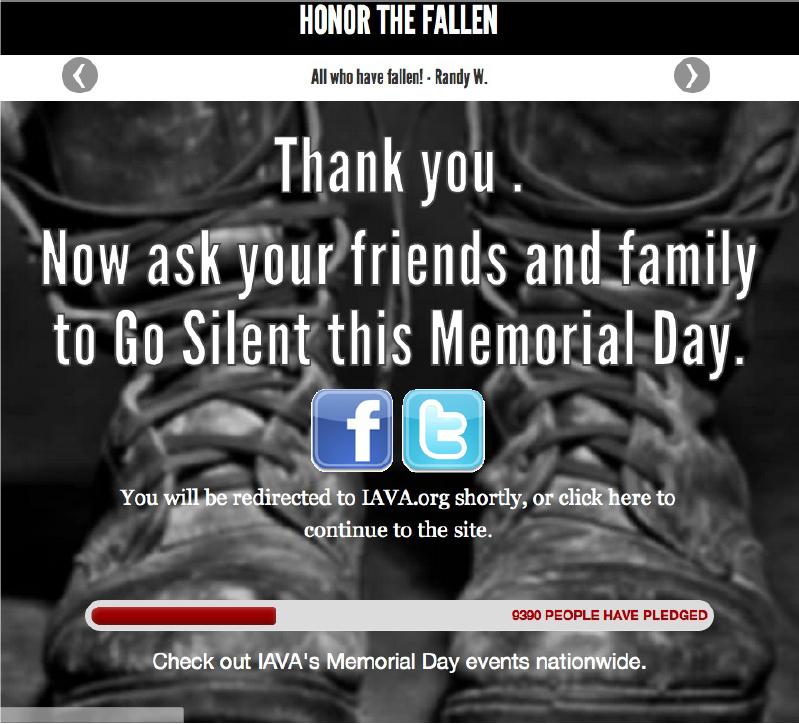
Email was a critical component of the campaign both to promote the campaign to those already on IAVA’s list and to immediately engage those who signed the pledge. IAVA sent “a series of three emails to [the] membership base, alerting them about the campaign prior to Memorial Day, then thanking them and giving an on-the-ground update on the day itself,” said Hemler.
Text Messages
IAVA used text messages to send reminders to those who signed up to “go silent” and to send live messages on Memorial Day. In Figure 6.5 you can see the email message received after pledging to “go silent”; it encourages recipients to sign up for the mobile reminders, thus ensuring that as many people as possible are in IAVA’s database with two kinds of communications options—an email address and a mobile phone number.
Figure 6.5 Email Confirmation Message for #Go Silent Supporters

Since IAVA already had such a large community on Facebook, it was important to make sure that the campaign was promoted there ahead of time and supporters had clear ways to get involved on the platform itself. Hemler notes that IAVA used Facebook “to spread the word and encourage Fans to sign the pledge, then share the pledge with their friends.” They also updated their profile image and the Timeline cover photo to brand the Facebook Page similarly to the website splash page. You can see what the Facebook Page looked like during the #GoSilent campaign in Figure 6.6.
Figure 6.6 IAVA’s #GoSilent Branded Facebook Page
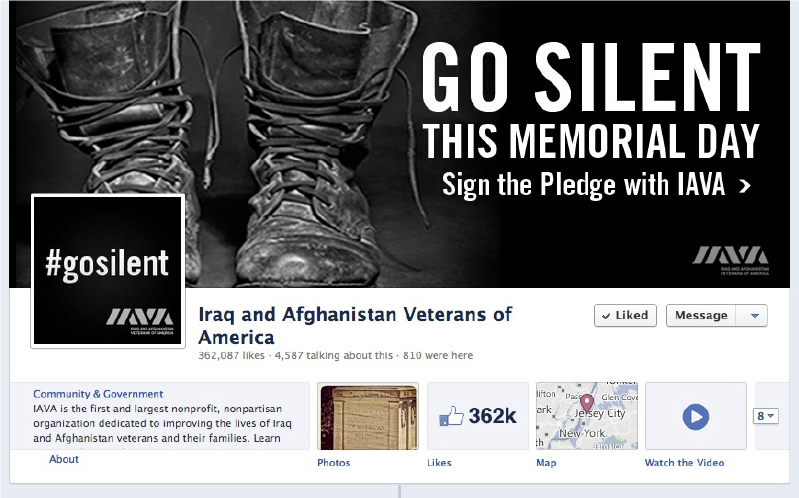
- Use plain text to ensure that the first email you send to new supporters does not go to the spam folder (as html-heavy messages often do).
- Encourage recipients to add your email address or domain to their contacts, thus ensuring that future messages make it to their in-box.
- Include suggested next steps based on the kind of action the supporter just did, like sharing their action on social channels or learning more about the campaign.
- Make it personal by introducing yourself as the staff member in charge of that campaign or program.
- Provide a preview of what the supporter can expect to happen next; for instance, mention the kind of email they will receive next or the next planned action for the campaign.
IAVA used Twitter to help connect the community across the country, with updates throughout the day, including live-tweeting the wreath laying ceremony in Arlington at the Tomb of the Unknowns. Hemler said, “We shared photos, updates from across the country, and messages of support.” IAVA modeled the behavior for the community, using Twitter to share updates, quotes from the president, and pictures of the ceremony. “Thousands of supporters on Twitter added a new level of poignancy to the campaign by tweeting the names of their fallen loved ones and friends. Our team made a conscious decision to retweet their ‘In Memoriam’ [messages] for thousands more to see and honor,” said Hemler.
IAVA had well-established communities on Facebook and Twitter before the #GoSilent campaign. It had less of a following on Instagram, an application for iPhone and Android phones for creating and editing photos. Instagram allows for easy sharing of photos from the application to be shared instantly on other platforms, including Facebook or Twitter. This meant IAVA could use Instagram, “to reach that platform’s wide fan base and utilize its popular appeal,” said Hemler, while also sharing the photos on Facebook and Twitter to further the reach of the images and diversify the day-of-event content posted to the online communities. Figure 6.7 shows a photo from Instagram posted to the IAVA Facebook Page, with nearly 3,000 “likes” in just an hour.
Figure 6.7 IAVA Instagram Photo Posted to Facebook Page
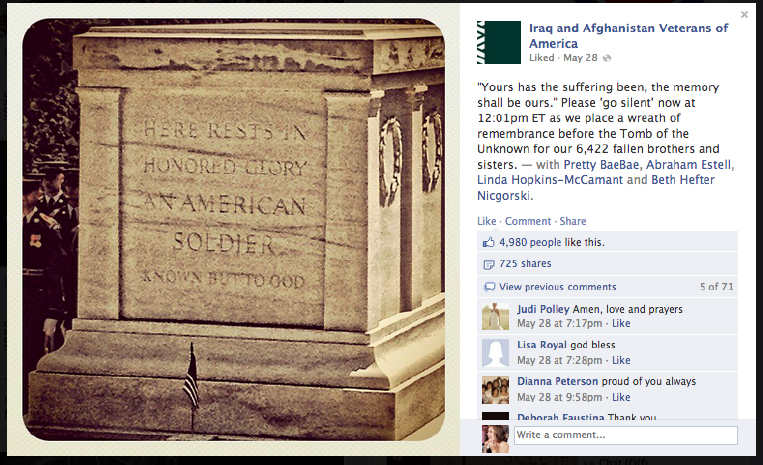
Results
From Hemler’s perspective, this was really a campaign focused on building community and “[raising] awareness around the true meaning of Memorial Day.” And what were the results? Hemler reported that IAVA “obtained over 5,000 pledges to observe the moment of silence, more than 30,000 page views, and nearly 400,000 people reached on Facebook.”
With campaigns focused on community building and awareness, it can be tricky to fully evaluate impact beyond just the number of interactions on content or sign-ups on the website. Hemler said, “to be honest, getting the right analysis has been a bit challenging because we didn’t run a similar campaign arc last year. Our donations didn’t see an increase from last year, although our email clicks were slightly above what was our current average (opens were about on par with that average).”
Some of the most important metrics in the IAVA campaign will be evaluated over the next few months. “We did see nearly a 10% increase in sign-ups when compared to the same time period last year—and we captured about 20% of those who signed the pledge onto our mobile text list, with nearly 60% of those sign-ups asking for more info from IAVA. All these are positive signs,” said Hemler. IAVA can compare this community growth against next year’s campaign. Staff can also evaluate messaging responses of these new supporters now that the campaign is wrapped up to identify what topics and actions they are most interested in, and will use those results to inform next year’s campaign.
Lessons
Even though IAVA considers the #GoSilent campaign a success, they are already planning how they will do better next year. Hemler explained that they “plan to alter the user experience slightly to make it even easier to sign the pledge, by displaying the pledge form directly on the pledge homepage, and perhaps enabling easier Facebook or Twitter connections.”
The 2012 #GoSilent campaign integrated activity across channels for supporters before and during the live event, as well as in real time, by sharing updates throughout the ceremony and encouraging those around the country to participate. IAVA wants to do even more in 2013, as Hemler reported: “We also hope to bridge the online versus offline experience by working with our program’s team to host more ceremonies and events nationwide and encourage civilians to join us on the ground in solidarity.”
We think the #GoSilent campaign from IAVA is a terrific example of a multichannel campaign that advances the organization’s mission, is based around the channels the community uses and the topics the community cares about, and stays focused on a larger vision that other people and organizations can support. When evaluating a campaign like this, it’s important to look at the percentage of people that signed up for more information from your organization, on email and mobile lists, and to track the level of activity from those people after the campaign. Segmenting your list by those that joined during a focused campaign like this can help you orient them to the rest of your work and move them to take other actions—whether advocacy or fundraising related—in the future.
We also recommend that any organization running a campaign like this use analytics tools to identify superfans and influential community members; this can mean looking at the retweets or analytics from URL shorteners on Twitter or the Insights data in Facebook. Identifying those people that were most influential to the community during your campaign now (even if they aren’t the “famous” people), will let you reach out to them ahead of the next campaign to prime them for action and provide them with exclusive or early content to share.
Now that you’ve seen how multichannel campaigns work in action to spark advocacy, raise money, and build community, we’ll show you in the next chapter how you can equip your organization for multichannel success.
DISCUSSION QUESTIONS
Spark a conversation with your team or organization about these core principles with the following questions:
NOTES
92. Deepwater Horizon information on Wikipedia: en.wikipedia.org/wiki/Deepwater_Horizon
94. www.nwf.org/Kids/Ranger-Rick/Parents-and-Educators/How-To-Talk-With-Kids-Gulf-Oil-Spill.aspx
